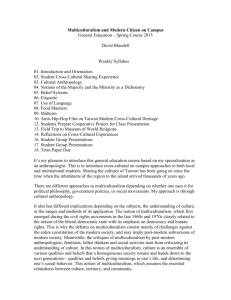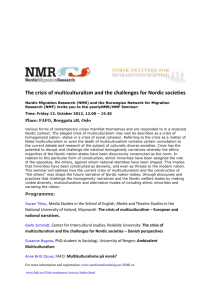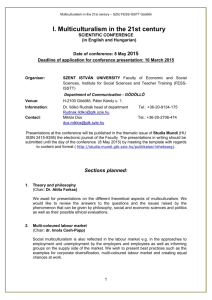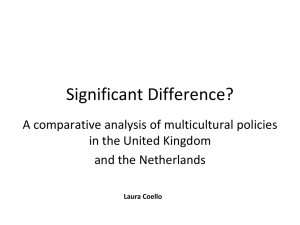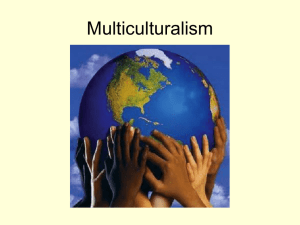`Interculturalism` or `critical multiculturalism`
advertisement
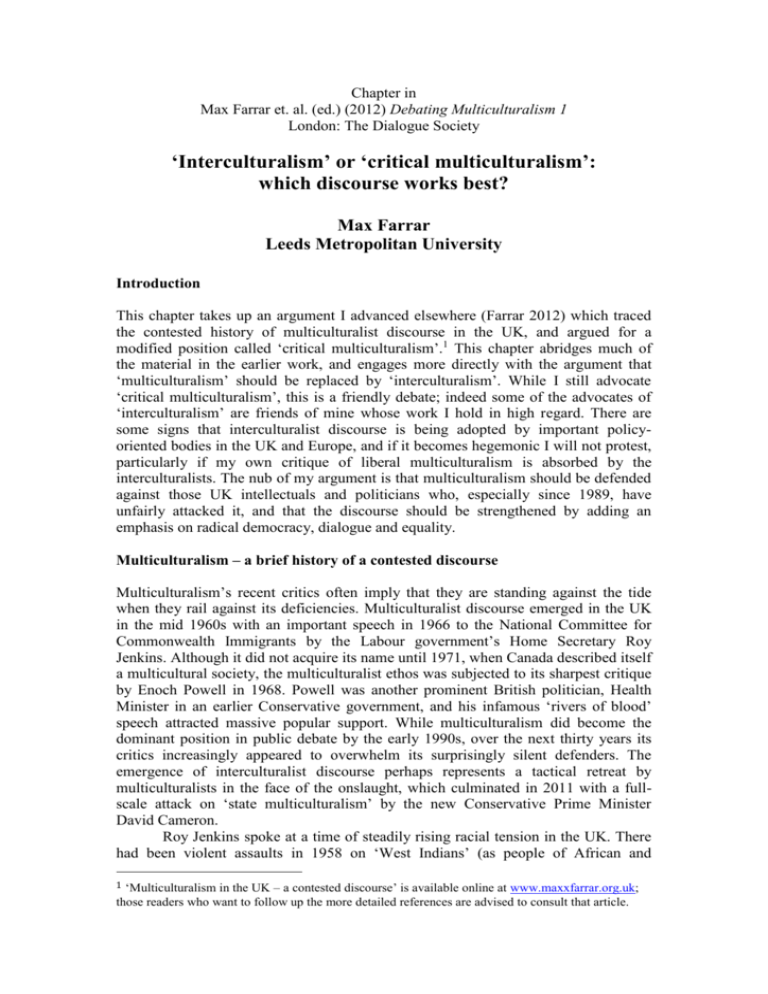
Chapter in Max Farrar et. al. (ed.) (2012) Debating Multiculturalism 1 London: The Dialogue Society ‘Interculturalism’ or ‘critical multiculturalism’: which discourse works best? Max Farrar Leeds Metropolitan University Introduction This chapter takes up an argument I advanced elsewhere (Farrar 2012) which traced the contested history of multiculturalist discourse in the UK, and argued for a modified position called ‘critical multiculturalism’.1 This chapter abridges much of the material in the earlier work, and engages more directly with the argument that ‘multiculturalism’ should be replaced by ‘interculturalism’. While I still advocate ‘critical multiculturalism’, this is a friendly debate; indeed some of the advocates of ‘interculturalism’ are friends of mine whose work I hold in high regard. There are some signs that interculturalist discourse is being adopted by important policyoriented bodies in the UK and Europe, and if it becomes hegemonic I will not protest, particularly if my own critique of liberal multiculturalism is absorbed by the interculturalists. The nub of my argument is that multiculturalism should be defended against those UK intellectuals and politicians who, especially since 1989, have unfairly attacked it, and that the discourse should be strengthened by adding an emphasis on radical democracy, dialogue and equality. Multiculturalism – a brief history of a contested discourse Multiculturalism’s recent critics often imply that they are standing against the tide when they rail against its deficiencies. Multiculturalist discourse emerged in the UK in the mid 1960s with an important speech in 1966 to the National Committee for Commonwealth Immigrants by the Labour government’s Home Secretary Roy Jenkins. Although it did not acquire its name until 1971, when Canada described itself a multicultural society, the multiculturalist ethos was subjected to its sharpest critique by Enoch Powell in 1968. Powell was another prominent British politician, Health Minister in an earlier Conservative government, and his infamous ‘rivers of blood’ speech attracted massive popular support. While multiculturalism did become the dominant position in public debate by the early 1990s, over the next thirty years its critics increasingly appeared to overwhelm its surprisingly silent defenders. The emergence of interculturalist discourse perhaps represents a tactical retreat by multiculturalists in the face of the onslaught, which culminated in 2011 with a fullscale attack on ‘state multiculturalism’ by the new Conservative Prime Minister David Cameron. Roy Jenkins spoke at a time of steadily rising racial tension in the UK. There had been violent assaults in 1958 on ‘West Indians’ (as people of African and 1 ‘Multiculturalism in the UK – a contested discourse’ is available online at www.maxxfarrar.org.uk; those readers who want to follow up the more detailed references are advised to consult that article. Caribbean heritage were called) in Notting Hill, London, and black people fought back over several nights. The remnants of Oswald Moseley’s fascist movement, and the British Ku Klux Klan sought to inflame public opinion even further. In 1964 the Conservative candidate in a Birmingham by-election gained election to Parliament after using the unconscionable slogan ‘If you want a nigger neighbour, vote Labour’. Roy Jenkins had observed the rise of the civil rights movement in the USA during the 1960s, led by the Ghandi-influenced Martin Luther King, with its more militant wings led by Malcolm X and the Black Panther Party. He envisioned a harmonious British society in terms which deserve close study. Setting out a position that came to be definitive for liberal-progressive opinion, Jenkins advocated the integration, rather than assimilation, of the ‘New Commonwealth’ (i.e. Caribbean, African and South Asian) populations who had begun to settle in the UK since the mid-1950s. Significantly, Jenkins defined integration as the nation’s goal, where integration is understood as ‘not a flattening process of assimilation but as equal opportunity accompanied by cultural diversity, in an atmosphere of mutual tolerance’ (Jenkins 1967 p.267). He was very explicit about what he did not regard as the nation’s goal: ‘I do not think that we need in this country a “melting pot”, which will turn everybody out in a common mould, as one of a series of carbon-copies of someone’s misplaced vision of the stereotypical Englishman . . . [this] would deprive us of most of the positive advantages of immigration, which . . . I believe to be very great indeed’ (Jenkins 1967 p.267). Whether these immigrants were the Normans, or Jewish refugees of the 1930s, ‘we have been constantly stimulated and jolted out of our natural lethargy by a whole series of immigrations’. He pointed to the advances immigrant brought to British businesses, universities, cultural centres and cities, none of whom would remain attractive if they were to turn inwards and only serve their own ‘racial group’. In a clear statement of the positive existential shock of immigration, Jenkins stated: ‘To live apart, for a person, a city, a country, is to lead a life of declining intellectual stimulation’. Furthermore, there is ‘no overall rational basis for resentment of the coloured immigrant population in our midst. Far from hindering our successful national development, they positively help it’ (Jenkins 1967 p.269). Acknowledging that there are irrational causes of resentment, and perhaps under-playing the racism already visible in Britain, he also argued that ‘we have as yet no established habit of hostility or bitterness on either side of the colour frontier’ (p.272). His use of ‘frontier’ spoke to a rather less optimistic scenario. Nevertheless, this speech was a landmark. Key features of multiculturalist discourse are expressed here by Jenkins: immigrants are a positive force in society; cultural difference is not to be ‘flattened’, but tolerated; equal opportunity (to provide for social and economic progress) is to be offered to new populations as a means towards their integration into the wider society; assimilation (i.e. the submerging of difference, by jettisoning the culture of origin) is rejected. In light of more recent debate, what seems to be the problem in Jenkins’s approach for the critics of multiculturalism is his stance against assimilation, and his willingness to embrace the integrity of the cultures that migrants bring with them to the UK. It is precisely this which I believe needs to be defended. Against the argument that this has led to the segregation of cultures in the UK, I suggest that it has been the platform upon which our relatively tolerant society has been built over the past fifty years. By not ‘flattening’ the newcomers’ cultures, the host culture (itself a product of centuries of immigration) has, in the main, learned to respect the best features of those cultures. The interculturalist argument gains strength, however, when it points out that there is much more to be done in building dialogue across cultures and in countering those tendencies which promote the view that one culture is superior to another. There is much to be learned from the debate that ensued in the UK as multiculturalist thinking gained ascendancy. Firstly, there were significant developments within conservative thinking and practice on race relations. Perhaps most important was the decision by Ted Heath, leader of the Conservative Party, to eject Enoch Powell from his Shadow Cabinet. Heath took advice from his senior colleagues, including ‘one-nation’ conservatives such as RA Butler and Edward Boyle who had supported Roy Jenkins’ anti-discrimination legislation and the community relations councils that were established in the late 1960s. By aligning the Conservative Party with multiculturalism, rather than British nationalism, Heath laid the basis for a report that surprised radicals and liberals in the mid 1980s. The Swann Report (1985) laid the foundations for multiculturalism in British schools. Its chair, Lord Swann, had been appointed by Conservative Prime Minister Margaret Thatcher in what was thought at the time to be a move against the liberal direction signalled in an earlier education report, chaired by an appointee of the previous Labour government, Lord Rampton. Just before she became Prime Minister, Margaret Thatcher, an implacable foe of Ted Heath, spoke for the Powellite rump in her party when she said: People are really rather afraid that this country might be rather swamped by people with a different culture . . . We are a British nation with British characteristics. Every country can take some small minorities and in many ways they add to the richness and variety of this country. The moment the minority threatens to become a big one, people get frightened . . . We are not in politics to ignore people’s worries: we are in politics to deal with them. (Thatcher 1978) Multiculturalists were outraged. Perhaps overlooking the ‘richness and variety’ phrase, they read ‘British characteristics’ as ‘white characteristics’ and they saw ‘swamped’ as a direct reference to Powell’s vicious prognosis of white Britain becoming brown Britain. Thatcher – who famously adopted the politician’s mantra ‘Never apologise, never explain’ – rode calmly over the storm this statement provoked as she built nationalist right wing of her party with the invasion of the Falkland Islands (the Malvinas) in 198… But Swann’s report was a direct rebuttal of this type of thinking. comprehensively rejected racism. It proposed that one of the key features of a new educational programme in schools would be what it called ‘the appreciation of diversity’. Swann puts its ambitions rather cautiously, but these are clearly infused with multiculturalist assumptions: ‘a variety of ethnic groups, with their own distinct lifestyle and value systems’ will be living together. Furthermore: It is also possible that there will be some degree of cultural interchange . . . A multi-cultural curriculum [will exist when] it is accepted by all sections of society that to draw on a diversity of cultural sources, and to incorporate a world perspective, was proper and unremarkable (Swann 1985 p. 324) Swann’s prediction came into effect rather more quickly than he seems to have expected. By the 1990s such a curriculum was commonplace, and while not all sections of society found it unremarkable to draw on diverse cultural sources, most young people did, as did significant proportions of the older generation. When, in 1995, Conservative Prime Minister John Major submitted to the United Nations a commitment that Britain wanted to ‘enable’ ethnic minorities to ‘maintain their own cultures, traditions, language and values’ (Runnymede Trust 1997 p.31) it seemed that multiculturalism was firmly embedded in the UK. The second development took place within liberal and socialist opinion. In brief, Marxists attacked multiculturalists in schools during the 1970s and 1980s for their liberal assumption that infusing children with ‘saris, samosas and steel bands’ would make a real difference in society. For the left, the crucial issue was to change the structures in society that generated racism. All London Teachers Against Racism and Fascism argued that teachers must ‘challenge inside and outside the school, the racism, sexism and class structures that divide us’. The debate was occasionally vitriolic, but the left’s view seemed to have been accepted when both the liberal National Association of Multiracial Education (NAME) and the National Union of Teachers adopted an anti-racist analysis in the early 1980s (Troyna and Williams 1986 p. 67). In 1999 Lord Macpherson, reporting on the police’s turpitude over the murder of Steven Lawrence, pronounced that ‘institutional racism’ existed within the Metropolitan Police. As this concept had been central to both liberal and left discourse on race over the previous thirty years, it seemed as though the rapprochement signalled by NAME’s agreement with the left over racism had born fruit in society as a whole. Although multiculturalism became the common currency of Conservative and Labour governments, backed up by successive laws against racial discrimination and the (somewhat indolent) Commission for Racial Equality, its opponents had not disappeared. But their focus shifted from race to culture. Given their historic role as champions of multiculturalism it might be surprising to some that liberals were among the most strident critics of those Muslims who demonstrated against the publication of Salman Rushdie’s Satanic Verses in 1988. The feminist novelist Fay Weldon wrote that the Quran is ‘food for no thought . . . It is not a poem on which society can be safely or sensibly based . . . It gives weapons and strength to the thought police’ (Weldon 1989 pp. 6-7). But the moral panic around Islam and British Muslims became fully apparent in the aftermath of the violent urban protest by Muslims living in four northern British towns in the early summer of 2001 and the attacks by Al Qaeda on New York and Washington in September of that year. The Cantle Report (2001) on the so-called ‘riots’ in three of these towns,2 had the negative effect of portraying British Muslims as leading ‘parallel lives’ to those of their white counterparts, and suggested that they actively engaged in ‘self-segregation’. The door was now wide open for a full-scale assault on multiculturalism. From the centre left, the writer Neil Ascherson (2004) described multiculturalism as ‘literally conservative’ because it reinforced ethnic identities. Also from the left, Kenan Malik (2009) denounced multiculturalism for legitimating the sedimentation of Islamic identities ever since the Rushdie affair. In the spirit of New Labour, Trevor Phillips, head of the Commission for Racial Equality, interviewed by the Times newspaper in 2004 said of multiculturalism: ‘The word is not useful any more’. Asked if it should be ‘killed off’, he replied: ‘Yes, let’s do that’. Completely departing from all that has been said in the past four decades about the virtues of multiculturalism as a platform for integration, but in line with the Cantle report, Phillips continued: ‘Multiculturalism suggests separateness’ (cited in Pitcher 2009 p. 164). If the centre left was rejecting multiculturalism, it is no surprise that the right was even more hostile. Daily Mail columnist Melanie Phillips (2006) blamed multiculturalism for the emergence of 2 Muslims in my home town of Leeds, who protested violently against police racism, were ignored. supporters of Al-Qaeda in the UK. By 2011, Conservative Prime Minister David Cameron appeared to abandon multiculturalism altogether when he argued that: Under the doctrine of state multiculturalism, we have encouraged different cultures to live separate lives, apart from each other and apart from the mainstream. We’ve failed to provide a vision of society to which they feel they want to belong. We’ve even tolerated these segregated communities behaving in ways that run completely counter to our values . . . instead of encouraging people to live apart, we need a clear sense of shared national identity that is open to everyone. (Cameron 2011) Although Cameron was clearly aligning himself with multiculturalism’s critics, it is important to note his more emollient statements. He completely rejected the hard right view that all Muslims were dangerous; he stressed that Western values and Islam can be ‘entirely compatible’; he agreed that the underlying issues of poverty and British foreign policy are important and that racism is to be condemned; he acknowledged the multiplicity of identity positions, ‘so people feel free to say, ‘Yes, I am a Muslim, I am a Hindu, I am Christian, but I am also a Londonder or a Berliner too’ (Cameron 2011). Thus Cameron appears to be jumping on a bandwagon moving away from multiculturalism – a wagon which previously had Labour Party leaders such as Tony Blair and Gordon Brown at the reins – while simultaneously riding the multiculturalist horse. Multiculturalist discourse thus remains at the heart of public discussion in the UK. As Ben Pitcher pointed out in his review of Labour’s record on this issue: Despite a recent appetite for obituary writing, pronouncements of the death of multiculturalism are premature . . . what is being subjected to criticism is the rhetorical status of the term ‘multiculturalism’ within that discourse . . . The purpose of this rejection [of ‘multiculturalism’] is to symbolise and benefit from popular anxiety about ‘separateness’, not to indicate a substantial change in policy and practice. (Pitcher 2009 p. 165, italics as in original) Interculturalism as a response to multiculturalism So far as I can see, the idea of interculturalism appeared in the early 2000s. Ireland’s National Consultative Committee of on Racism and Interculturalism provided this definition in 2002: Interculturalism suggests the acceptance not only of principles of equality of rights, values and abilities, but also the development of policies to promote interaction, collaboration and exchange with people of different cultures, ethnicity or religion living in the same territory. Furthermore, interculturalism is an approach that sees difference as something positive that can enrich a society and recognizes racism as an issue that needs to be tackled to create a more inclusive society. The concept of interculturalism has replaced earlier concepts of assimilation and multiculturalism. (Cited in Titley 2012) The statement that it has ‘replaced’ multiculturalism was perhaps premature, at least for the UK, but others have discussed the term on the assumption that multiculturalism has failed. Leonie Sandercock argued for a ‘re-theorisation’ of multiculturalism, applying Stuart Hall’s sociology of the multiple identifications adopted in multicultural Britain. Writing the key-note chapter for the Intercultural City Reader she offered interculturalism as the replacement for multiculturalism (Sandercock 2004). Malcolm James (for the Baring Foundation) advocated interculturalism as a deliberate ‘move away from models for post-colonial society based on sealed cultural groups (multiculturalism and community cohesion)’ (James 2009 p.3). The context for these developments appears to be the spread across Europe of a critique of multiculturalism. Titley (2012) notes the hostility to multiculturalism mounted in Germany, the Netherlands, Sweden and the UK, while reminding us that France had never signed up in the first place. Ali Rattansi (2011 p.4), who has a long and distinguished career in the sociology of British race relations, has pointed out that most of the criticisms of multiculturalism made throughout Europe are ‘either misguided or exaggerated’, but he too supports the move to interculturalism as the preferred discourse in this period. The major European Commission/Council of Europe ‘Intercultural Cities’ programme, started in 2008, is an indicator of just how effective the campaign against multiculturalist discourse has been. In that initiative, interculturalism was defined as ‘a concept that promotes policies and practices that encourage interaction, understanding and respect between different cultures and ethnic groups’ (Wood 2009 p.11). The programme was conceived of as ‘part of our shared vision of an intercultural Europe which values human dignity, civic participation and respect for diversity as the foundation stones for socially and economically strong communities’ (p.13). Further, the intercultural city is one which ‘actively combats prejudice and discrimination and ensures equal opportunities for all’ (p. 17). Ali Rattansi, having traced the achievements of multiculturalist thinking and practice, argued for the new concept in these terms: Use of the notion of interculturalism acts, instead, to undercut this essentialist tendency [in multiculturalism] – it cannot by itself completely prevent it – by building in a conception of connectedness, interaction, and interweaving between the beliefs, practices, and lifestyles of different (not separate) ethnic groups as part of national cultures that are in constant flux. (Rattansi 2011 p.153). He continued: There is now an urgent need for a transformation of the vocabulary of multiculturalism into that of ‘interculturalism’, with a corresponding shift to underpinning premises which highlight the deep historical interconnectedness of cultures and an understanding of how conceptions of tolerance, liberty, rationality, and so forth are shared across ‘civilizations’, and in particular how non-Western cultures have made a vital contribution to the development of these ideas and their appropriate institutions. Modernity is not a uniquely Western phenomenon, but a shared Eurasian achievement. (Rattansi 2011 p.159). None of this sounds very different from Roy Jenkins’ statement in 1966, quoted above. Indeed, if we add Tariq Modood’s authoritative definition of multiculturalism to Jenkins’ original approach, it would be hard to see how interculturalism improves upon multiculturalism: Multiculturalism is where processes of integration are seen both as two-way and as working differently for different groups. In this understanding, each group is distinctive, and thus integration cannot consist of a single template (hence the ‘multi’) . . . ‘culturalism’ . . . refers to the understanding that the groups in question are likely to not just to be marked by newness or phenotype or socio-economic location but by certain forms of group identities. The latter point indeed suggests that a better, though longer, term might be “pluralistic integration”. In the perspective of multiculturalism, the social requirement to treat these group identities with respect leads to a redefinition of the concept of equality. Modood (2005) What Modood provides here is the affirmation of group identities and the recognition that these group identities will change in response to each other over a period of time. Thus integration is achieved (as all the various groups, including the white-skinned ones) adjust their identifications. Intercultural dialogue is obviously one of the means by which these changes take place. Throughout his work, Modood has emphasised the role of equal opportunity and publicly legitimated opposition to racism as other aspects of the process. Malcolm James’ definition wraps all these ideas together in this form, and again it is hard to see what the differences with multiculturalism actually are: Interculturality is a dynamic process whereby people from different cultures interact to learn about and question their own and each other’s cultures. Over time this may lead to cultural change. It recognises the inequalities at work in society and the need to overcome these. It is a process which requires mutual respect and acknowledges human rights. (James 2007 p.2) Interculturalists will no doubt stress that their approach is more active in promoting dialogue than some multiculturalists have been. Spearheaded by the European Year of Intercultural Dialogue in 2008, an interculturalist programme was developed in eleven cities, but none in Britain. The Baring Foundation sponsored a large programme of intercultural dialogue in Britain. In his review of the bids for Baring’s funds, Malcolm James was unimpressed by the concepts offered by organisations aiming to deliver these programmes. He argued that their key concepts ‘community’, ‘culture’, ‘contact’, ‘parallel lives’, and ‘community cohesion’ – were inappropriate because they are often based on fixed notions of ethnicity and geography which limit the possibility of facilitating intercultural relations through social policy because they restrict humans to the boundaries of neighbourhoods, skin colour and certain cultural practices. These limitations deny everything else that humans are – complex, contradictory, changing and socially structured. Until policy makers address these concerns and realities, oppressive and discriminatory ways of living will not be eradicated. (James 2009 pp. 2-3) The argument that ethnic minorities in Britain – actually, the focus was on Muslims – were leading ‘parallel lives’ was one of the spurs for the further critique of multiculturalism in the aftermath of the violent urban protest in the northern cities in 2001. “Community cohesion’ was the government policy that resulted from the reports into those so-called ‘riots’ (Farrar 2009). The ‘contact hypothesis’ – that prejudice decreases, and a sense of joint community rises, when rival cultures are brought into dialogue with each other – was the theory that underlay the community cohesion initiatives. So it is hardly surprising that intercultural programmes would replicate those ideas. But James went so far as to argue that all these ideas should be abandoned. Just as the Marxist anti-racists criticized the multiculturalists for ignoring racism and class oppression (see above), James argued for a notion of interculturalism that included (amongst other things): social action around all forms of discrimination and disadvantage, and in particular ‘race’, gender, sexuality, poverty, age and class that government take responsibility for structural inequalities [and] support for anti-racist methodologies that address histories of racism (James 2009 p.16). In my view, James is right to argue that interculturalist discourse should take the structural aspects of discrimination (in all sectors of society) into consideration, and should link itself to anti-racism, just as multiculturalism should. Further critique of interculturalist thinking and practice in education and youth work in Europe has come from Gavan Titley. He describes this as a ‘failed experiment’. It has failed because it sees culture in an essentialised and reductive form, thereby losing sight of the ‘mixedness’ and the diffusions that permeate culture. (This resonates with James’ point that humans are ‘complex, contradictory and changing’ – so, therefore, are the cultures they create.) But Titley goes further than this. He argues that interculturalism rests upon racial categories that it holds in common with those it opposes. Thus, when the response to intercultural dialogue is ‘We tried to talk with them but they just won’t change’ a hardening of positions take place and racism resurfaces. The clear implication of Titley’s argument is that the very categories of ‘race’ and ‘culture’ must be unpicked. It is well known that ‘race’ has no validity as a scientific concept, but it is not so widely recognised that cultures have also been understood in essentialised terms and placed in a hierarchy (often embrocated with the spurious biology of ‘race’). Culture thus works, as ‘race’ does, to categorise and differentiate human groups (Lentin and Titley 2011). The view that immigrants disturb and degrade ‘our culture’ is a type of common sense, and that people’s fear of this process is natural, flows easily from the theory that cultures can be described in a ladder of value. It is just this ‘non racial’ viewpoint that the new right parties have developed over the past thirty years. Titley (2012) argues that intercultural learning programmes are vulnerable to challenge from the right precisely because they rest on similar assumptions about culture, and because they buy into the argument that multiculturalism has failed. Since this argument itself has been motivated by increasingly hostile characterisations of Muslims ever since the Rushdie affair, it would seem essential to simultaneously defend the integrity of Islam and the rights of Muslims, and to offer a qualified defence of multiculturalism. Interculturalist discourse, at best, offers no real improvements on ‘anti-racist’ multiculturalism; at worst it plays into the hands of those who seek to valorise ‘Western’ culture (which, at its most extreme, means ‘Aryan’ culture) over all the others. Critical multiculturalism Insofar as it contained simplistic, essentialised notions of identity and culture multiculturalism suffered from the defects of interculturalism. In its rapprochement with anti-racism, multiculturalism overcame its early weakness of neglecting the way that class, ‘race’ and gender structured the processes of discrimination faced by minority groups. As it embraced the theory that identities are unstable, multiple, developing and capable of melding, multiculturalist discourse, backed by legislation and equal opportunity programmes, helped shape the UK into a society which is widely recognised as being more tolerant of difference than any of its European neighbours. In the chapter referred to at the outset (Farrar 2012) I offered an outline of a new discourse – labelled critical multiculturalism – which I argue would provide a platform for further progressive development of UK. These are its components: 1) support for Bhikhu Parekh’s version of Britain as a ‘community of communities’, where difference is respected; 2) support for Tariq Modood’s notion of ‘two-way integration’, where the identities of all ethnic groups (including those that are white-skinned) undergo processes of change as the overarching national community emerges; 3) recognition that these two features entail a negotiation of diversity, rather than the uncritical celebration of diversity advocated by some liberal multiculturalists. Critical multiculturalists, for instance, would support homosexual rights, reject any type of coercion of women, and promote the sexual and geographical mixing of ethnic groups. But they would oppose the coalition government’s refusal in 2011 even to talk to political Islamists. Instead, they would promote dialogue and debate on all points of difference between and among all ethnic groups; 4) adoption of a strong position on full legal rights for all ethnic minorities, and strict implementation of equal treatment regardless of ethnicity (as outlined by Will Kymlicka) – relentlessly opposing, therefore, discrimination in any form; 5) explicitly linking these integration processes to the discourse on radical democracy. Every ethnic group needs to be fully and meaningfully engaged in the civic life of the nation, which requires effective political power to be transferred from the centre to the localities; 6) recognition that economic discrimination is as important as cultural discrimination in the generation of disadvantage; thus critical multiculturalism advocates economic equality as well as legal and cultural equality. Two of these points explicitly differentiate critical multiculturalism from liberal multiculturalism. Point (2) sets critical multiculturalism against cultural relativism: it aligns itself with those who take a radical view on the rights of sexual minorities. While not seeking make any claims for the cultural superiority of those nations which protest the rights of sexual minorities, it does stand up for those rights, and seeks actively to persuade others of their validity. Point (6) above moves the debate away from the cultural dimension of social life to the economic, and critical multiculturalism aligns itself with radical leftists who oppose neo-liberal capitalism and who support social democracy. Programmes of action which embody this type of thought would, it seems to me, provide a real basis for social progress. Bibiography Cameron, David (2011) Prime Minister’s speech on radicalisation and Islamic extremism at the Munich Security Conference, 5th February 2011. www.number10.gov.uk/news/speeches-and-transcripts/2011/02/pms-speech-atmunich-security-conference-60293 Accessed 23.02.2011 Farrar, Max (2009) ‘Violent Urban Protest – identities, ethics and Islamism’ in Bhattacharyya, Gargi (ed.) (2009) Ethnicities and Values in a Changing world, Farnham: Ashgate. Farrar, Max (2012 forthcoming) ‘Multiculturalism in the UK – a contested discourse’ in Farrar, Max, Simon Robinson, Yasmin Valli, and Paul Wetherly (eds) (2012, forthcoming) ‘Islam’ and ‘the West’ – Key issues in multiculturalism, London: Palgrave. James, Malcolm (2008) Interculturalism: Theory and Practice, London: Baring Foundation James, Malcolm (2009) Interculturalism: Social Policy and Grassroots Work, London: Baring Foundation Jenkins, Roy (1967) Essays and Speeches, London: Collins. Lentin, Alana and Gavan Titley (2011) The Crises of Multiculturalism: Racism in a Neoliberal Age. London: Zed Books Modood, Tariq (2005) ‘Remaking Multicultrualism after 7/7’ OpenDemocracy 28 September 2005, available at www.opendemocracy.net/conflictterrorism/multiculturalism_2879.jsp Accessed 14.02.2012 Pitcher, Ben (2009) The Politics of Multiculturalism – Race and racism in contemporary Britain, Basingstoke: Palgrave Macmillan. Rattaansi, Ali (2011) Multiculturalism – A very short introduction, Oxford: Oxford University Press. Runnymede Trust (1997) Islamophobia: A challenge to us all by the Commission on British Muslims and Islamophobia, chaired by Professor Gordon Conway. Sandercock, Leonie (2004) ‘Reconsidering Multiculturalism: Towards and Intercutlrual Project’ in Wood, Phil (ed.) (2004) Intercultural City Reader, Stroud: Comedia. Swann, Lord (1985) Education for All – the report of the committee of enquiry into the education of children from ethnic minority groups, London: HMSO, Cmnd 9453. Titley, Gavan (2012) ‘After the failed experiment: intercultural learning in a multicultural crisis’ in Yael, Ohana and Henrdik Otten (eds) (2012) Where Do You Stand? Intercultural Learning and Political Education in Contemporary Europe, Wiesbaden: VS Verlag. Troyna, Barry & Williams, Jenny (1986) Racism, Education and the State, London: Routledge. Weldon, Faye (1989) Sacred Cows – a portrait of Britain post-Rushdie pre-utopia, London; Chatto and Windus. Wood, Phil (ed.) (2009) Intercultural Cities – Towards a model for intercultural integration, Strasburg: Council of Europe Publishing.
